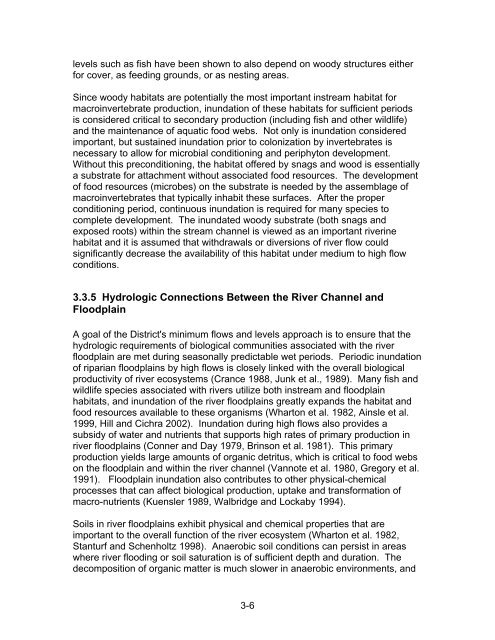Chapter 1 Minimum Flows and Levels - Southwest Florida Water ...
Chapter 1 Minimum Flows and Levels - Southwest Florida Water ...
Chapter 1 Minimum Flows and Levels - Southwest Florida Water ...
You also want an ePaper? Increase the reach of your titles
YUMPU automatically turns print PDFs into web optimized ePapers that Google loves.
levels such as fish have been shown to also depend on woody structures either<br />
for cover, as feeding grounds, or as nesting areas.<br />
Since woody habitats are potentially the most important instream habitat for<br />
macroinvertebrate production, inundation of these habitats for sufficient periods<br />
is considered critical to secondary production (including fish <strong>and</strong> other wildlife)<br />
<strong>and</strong> the maintenance of aquatic food webs. Not only is inundation considered<br />
important, but sustained inundation prior to colonization by invertebrates is<br />
necessary to allow for microbial conditioning <strong>and</strong> periphyton development.<br />
Without this preconditioning, the habitat offered by snags <strong>and</strong> wood is essentially<br />
a substrate for attachment without associated food resources. The development<br />
of food resources (microbes) on the substrate is needed by the assemblage of<br />
macroinvertebrates that typically inhabit these surfaces. After the proper<br />
conditioning period, continuous inundation is required for many species to<br />
complete development. The inundated woody substrate (both snags <strong>and</strong><br />
exposed roots) within the stream channel is viewed as an important riverine<br />
habitat <strong>and</strong> it is assumed that withdrawals or diversions of river flow could<br />
significantly decrease the availability of this habitat under medium to high flow<br />
conditions.<br />
3.3.5 Hydrologic Connections Between the River Channel <strong>and</strong><br />
Floodplain<br />
A goal of the District's minimum flows <strong>and</strong> levels approach is to ensure that the<br />
hydrologic requirements of biological communities associated with the river<br />
floodplain are met during seasonally predictable wet periods. Periodic inundation<br />
of riparian floodplains by high flows is closely linked with the overall biological<br />
productivity of river ecosystems (Crance 1988, Junk et al., 1989). Many fish <strong>and</strong><br />
wildlife species associated with rivers utilize both instream <strong>and</strong> floodplain<br />
habitats, <strong>and</strong> inundation of the river floodplains greatly exp<strong>and</strong>s the habitat <strong>and</strong><br />
food resources available to these organisms (Wharton et al. 1982, Ainsle et al.<br />
1999, Hill <strong>and</strong> Cichra 2002). Inundation during high flows also provides a<br />
subsidy of water <strong>and</strong> nutrients that supports high rates of primary production in<br />
river floodplains (Conner <strong>and</strong> Day 1979, Brinson et al. 1981). This primary<br />
production yields large amounts of organic detritus, which is critical to food webs<br />
on the floodplain <strong>and</strong> within the river channel (Vannote et al. 1980, Gregory et al.<br />
1991). Floodplain inundation also contributes to other physical-chemical<br />
processes that can affect biological production, uptake <strong>and</strong> transformation of<br />
macro-nutrients (Kuensler 1989, Walbridge <strong>and</strong> Lockaby 1994).<br />
Soils in river floodplains exhibit physical <strong>and</strong> chemical properties that are<br />
important to the overall function of the river ecosystem (Wharton et al. 1982,<br />
Stanturf <strong>and</strong> Schenholtz 1998). Anaerobic soil conditions can persist in areas<br />
where river flooding or soil saturation is of sufficient depth <strong>and</strong> duration. The<br />
decomposition of organic matter is much slower in anaerobic environments, <strong>and</strong><br />
3-6
















